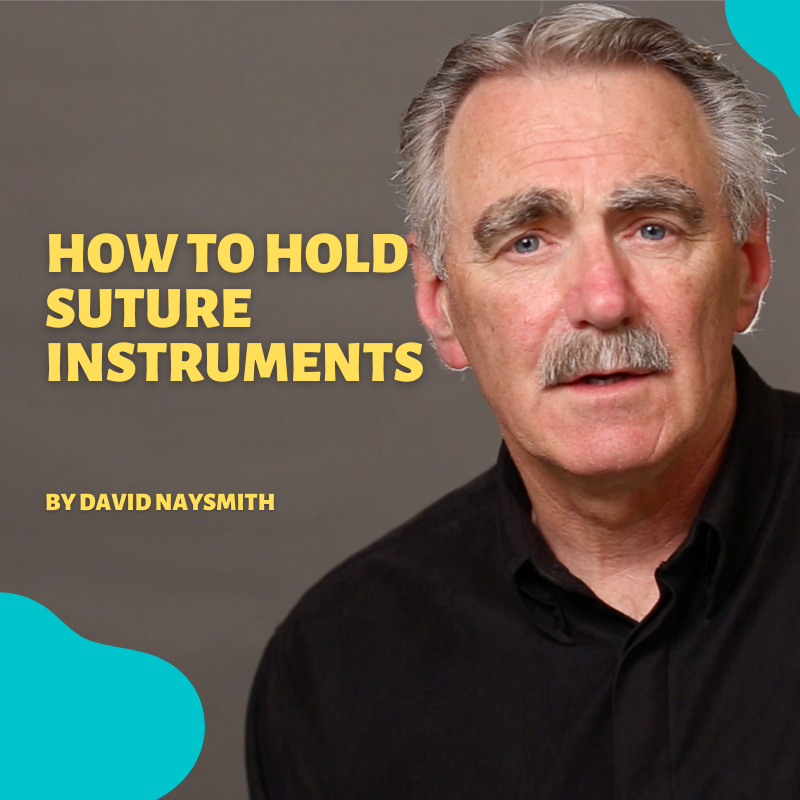How to hold THE INSTRUMENTS
Anytime we wish to close wounds with sutures we must use instruments to help us place the stitch, tie the suture material and cut it. As well, the wounds we are closing are often ones that we have made while cutting out diseased/damaged tissue and so we also must know how to manage a scalpel.

Pictured here (fig. 1) are the basic instruments required for suturing. From left to right are:
- a needle driver/holder
- a toothed forceps
- a pair of iris scissors
- a scalpel - it may be a traditional scalpel with disposable blade (as pictured here) or a totally disposable plastic scalpel with or without a “safety blade”
Also pictured here is a suture – in this case a 4-0 silk suture on a 3/8 circle cutting needle.
Holding THE NEEDLE DRIVER
Depending on your skill level and the technique you may be using, there are different ways to hold the needle driver (eg. palm grip, reverse grip). I will show the most common and basic way to handle this instrument. (fig. 2. and fig. 3) This technique will work well for almost everything you need to do.
Note: The needle driver is held with three-point support:
- The thumb
- The index finger
- The ring finger (some prefer the long)
This is essentially a tripod support and allows for great control of the instrument and the needle that is on the end of it. Note the position of the long finger, giving even more control.


Note: The needle driver is supported on the tips of the digits so the digits (thumb, and ring) are NOT too far into the rings of the instrument.
See fig. 4 for what NOT TO DO. Placing the fingers too far into the instrument makes it very difficult to manipulate with dexterity and almost impossible to get off the hand when you wish to pick up another instrument. Try it and you will see what I mean.

Note: Beginners are tempted to put the thumb in one ring of the driver and the index in the other (fig. 5). This is a VERY UNSTABLE way to use the instrument and will lead to a great deal of frustration. Try it and see.

Holding THE SCISSORS
Much like the needle driver, the scissor is an instrument with two rings – for digits, and a working bit extending out from them. The grip for the scissors should be exactly as that for the needle driver – a tripod of support using the thumb, index and ring fingers (fig. 6).

Again: Do not put the digits too far into the rings.
Note: This is IMPORTANT - if you wish to be precise and in control of the instrument, look at what I call “the finger rest” that the SMALL finger provides (fig. 7).

This allows you to make very fine movements of the scissor tips. If you do not have a finger rest then the instrument is balancing in space using your shoulder, elbow and wrist – all very gross movements. Try it and see what I mean.
Holding THE TOOTHED FORCEPS
I have stressed the word TOOTHED (fig. 8) in describing this instrument. Although you might think that a tooth, or teeth might be damaging to tissue and that a non-toothed forceps would be less damaging – this is not the case. Using a non-toothed forceps to try and hold tissue is extremely frustrating.

Figure 8
Gentle (and I stress the word “gentle”) handling with a toothed instrument is the way to go. After handling the wound edge with the toothed instrument, you should not see “bite marks” along the wound edge.
For most purposes the forceps is held exactly as you would hold a pen (fig. 9). Although there are (rare) circumstances where you would use a palm grip (fig. 10), these are few and far between. For suturing DO NOT USE A PALM GRIP. I call this the CSI GRIP because it is frequently seen on television programs and is an indication that they don’t know what they are doing! DON’T DO IT !

Figure 9

Figure 10
Note: Once again we see the “finger rest” giving support and allowing for fine control of the tips ( look at the small and ring fingers in fig. 9). You cannot get this control with the CSI GRIP (fig. 10).
Note: If you are picking up a needle with the forceps, do so by putting the needle just above the teeth of the forceps and squeezing tight (fig. 11). Don’t try to pick it up with the toothed tips - very frustrating.

Figure 11
Handling THE SCALPEL
The best way to hold the scalpel depends entirely upon the nature of the cut you wish to make. There is a pen grip (fig. 12) for making small fine cuts. The palm grip (fig. 13) is used for longer cuts.

Figure 12

Figure 13
Note: When using the pen grip or the palm grip the small and possibly the ring fingers act a “finger rests” (fig. 14). to allow for very fine control.

Figure 14
Note: When using either the pen grip or the palm grip, try to cut with “the belly” (fig. 15) of the blade.

Figure 15




Leave a comment
All comments are moderated before being published.
This site is protected by hCaptcha and the hCaptcha Privacy Policy and Terms of Service apply.